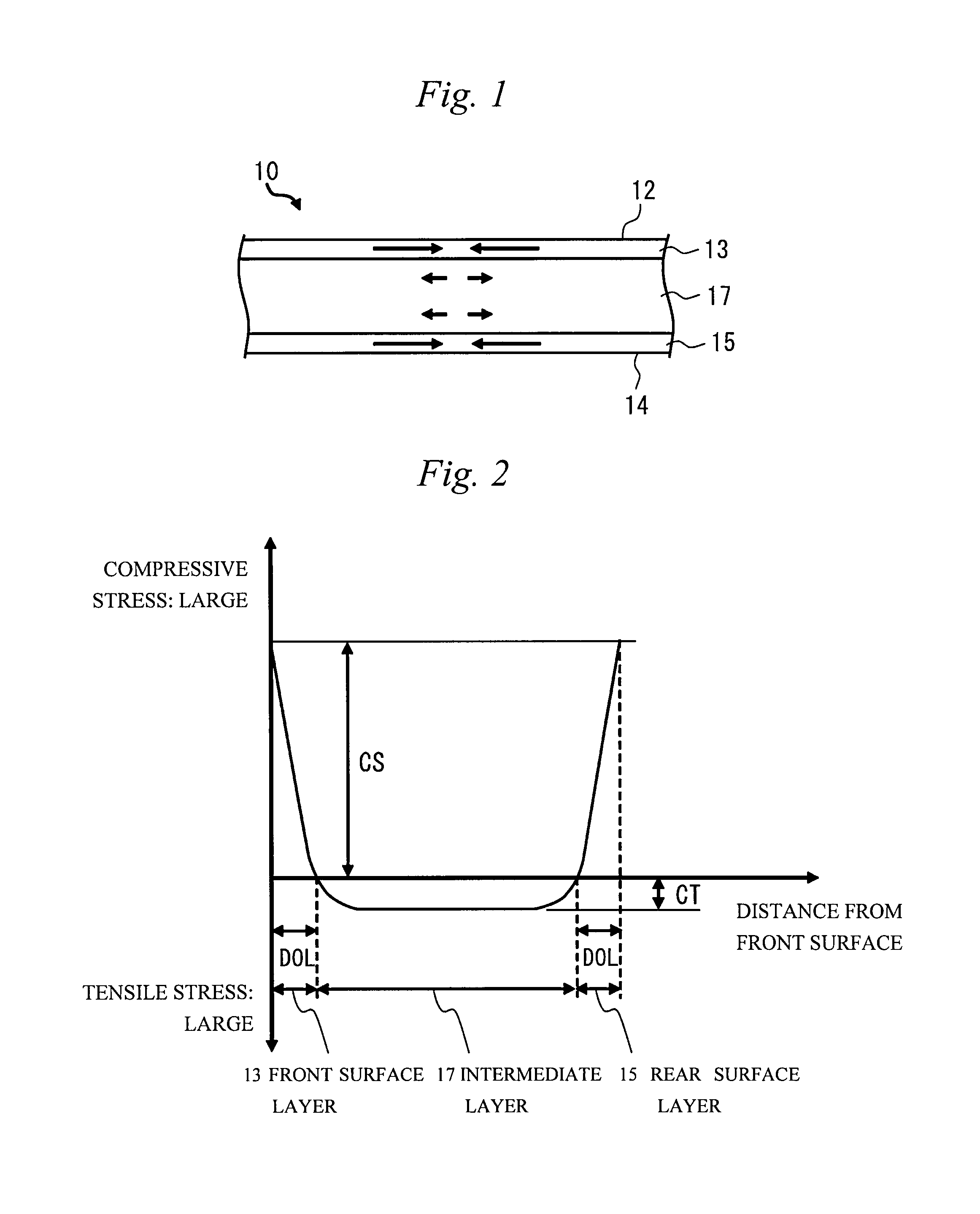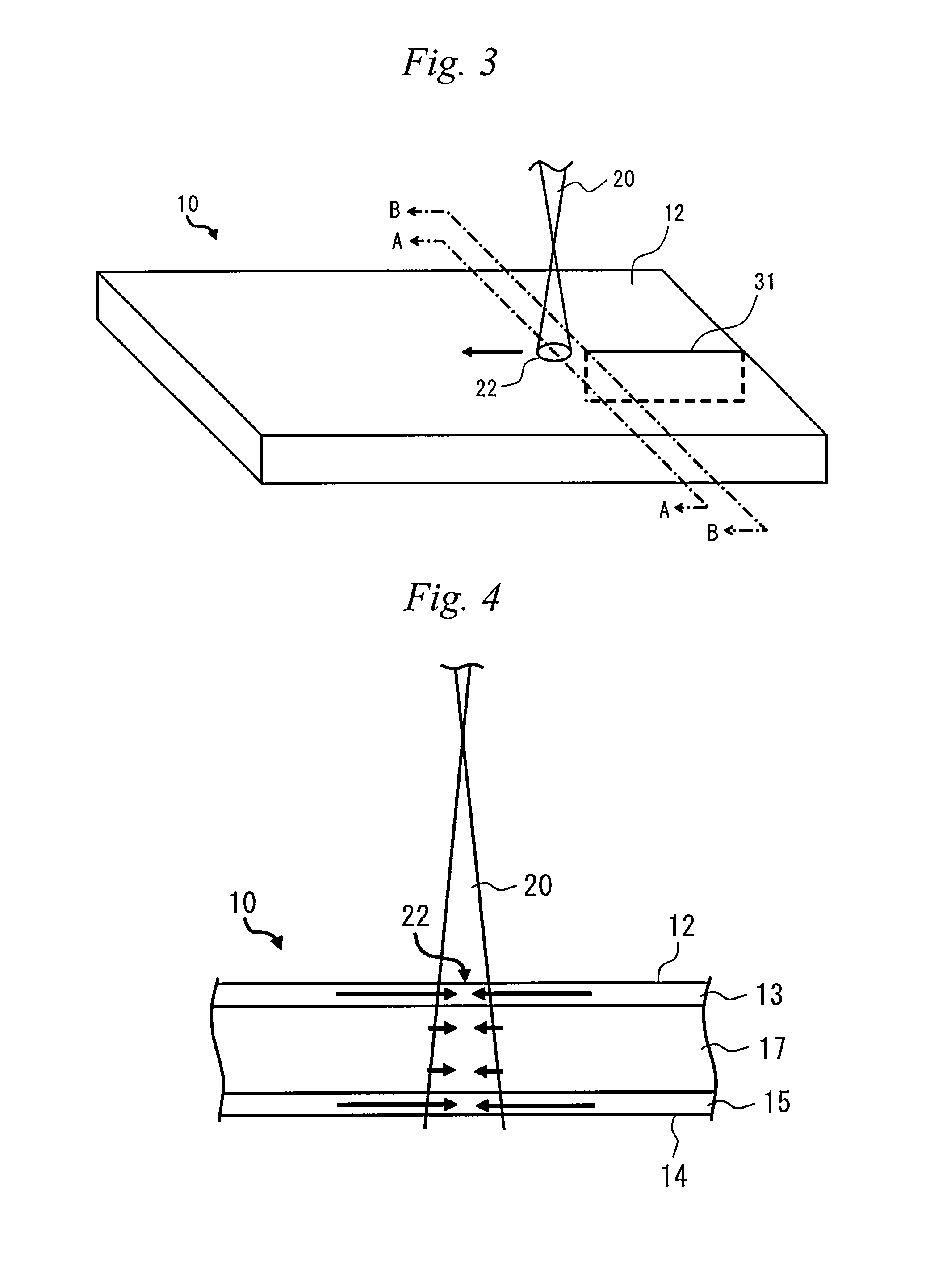Cutting method for reinforced glass plate and reinforced glass plate cutting device
a cutting device and cutting method technology, applied in glass making apparatus, manufacturing tools, instruments, etc., can solve problems such as quality degradation of cut reinforced glass sheets, and achieve the effect of not causing quality degradation
- Summary
- Abstract
- Description
- Claims
- Application Information
AI Technical Summary
Benefits of technology
Problems solved by technology
Method used
Image
Examples
example 1
[0110]In Example 1, a strengthened glass sheet having a sheet thickness of 0.7 (mm), a surface compressive stress CS of 761.6 (MPa), a thickness DOL of each of the front surface layer and the rear surface layer of 39.7 (μm) and an inside residual tensile stress CT of 48.7 (MPa) was used.
[0111]The inside residual tensile stress CT of the strengthened glass sheet was obtained as follows. The surface compressive stress CS and the thicknesses DOL of the compressive stress layers (the front surface layer and the rear surface layer) were measured using a surface stress meter FSM-6000 (manufactured by Orihara Industrial Co., Ltd.) and the inside residual tensile stress was calculated from the measured values and the thickness t of the strengthened glass sheet using the following formula (2).
CT=(CS×DOL) / (t−2×DOL) (2)
[0112]The strengthened glass sheet was cut using the cutting method described in the present embodiment. An initial crack was formed in advance in the cutting initiation locati...
example 2
[0123]Next, Example 2 of the invention will be described. In Example 2, the relationship between the inside residual tensile stress CT in the intermediate layer in the strengthened glass sheet and the irradiation energy E (J / mm2) per unit irradiation area of the laser beam will be specifically described.
[0124]In Example 2, a strengthened glass sheet having a sheet thickness of 1.1 (mm) was used. The value of the inside residual tensile stress CT was changed in accordance with the samples. The inside residual tensile stress CT was adjusted using the concentration and temperature of the treatment liquid for treating the glass, the immersion time of the glass in the treatment liquid, and the like in the chemical strengthening method. The strengthened glass sheet was cut using the cutting method described in the embodiment. An initial crack was formed in advance in the cutting initiation location at an end portion of the strengthened glass sheet, but scribe lines were not formed on the ...
example 3
[0132]Next, Example 3 of the invention will be described. In Example 3, the relationship between the scanning rate of the laser beam when cutting the strengthened glass sheet and the irradiation energy E (J / mm2) per unit irradiation area of the laser beam will be specifically described.
[0133]In Example 3, a strengthened glass sheet having a sheet thickness of 1.1 (mm), a surface compressive stress CS of 789 (MPa), a thickness DOL of each of the front surface layer and the rear surface layer of 36.6 (μm) and an inside residual tensile stress CT of 28.1 (MPa) was used.
[0134]The strengthened glass sheet was cut using the cutting method described in the embodiment. An initial crack was formed in advance in the cutting initiation location at an end portion of the strengthened glass sheet, but scribe lines were not formed on the surface of the strengthened glass sheet. A fiber laser (central wavelength band of 1070 nm) was used as the light source of the laser beam. In Example 3, the stre...
PUM
| Property | Measurement | Unit |
|---|---|---|
| wavelength | aaaaa | aaaaa |
| wavelength | aaaaa | aaaaa |
| wavelength | aaaaa | aaaaa |
Abstract
Description
Claims
Application Information
 Login to View More
Login to View More - R&D
- Intellectual Property
- Life Sciences
- Materials
- Tech Scout
- Unparalleled Data Quality
- Higher Quality Content
- 60% Fewer Hallucinations
Browse by: Latest US Patents, China's latest patents, Technical Efficacy Thesaurus, Application Domain, Technology Topic, Popular Technical Reports.
© 2025 PatSnap. All rights reserved.Legal|Privacy policy|Modern Slavery Act Transparency Statement|Sitemap|About US| Contact US: help@patsnap.com



